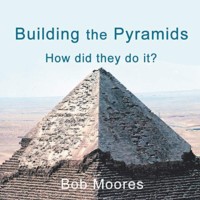Title: Building the Pyramids: How Did They Do It?
Author: Bob Moores
Publisher: iUniverse
ISBN: 978-1-5320-7705-0
Pages: 326
Genre: Historical
Reviewed by: Jason Lulos
Pacific Book Review
Building the Pyramids is a superbly written and thorough analysis of how the pyramids were built. Not just for historians and engineers, this book is accessible to any reader with an interest in the mystery of how ancient builders were able to achieve these architectural feats which seem way ahead of their time.
Bob Moores has a mechanical engineering degree from Johns Hopkins University and spent his career in product development design for Black & Decker/DeWalt. His background is ideal for studying ancient engineering. And he clearly has a passion for it, having studied the pyramids as a “hobby” for nearly half a century. In addition to his scientific and scholarly research, he has studied the pyramids in person. This includes a trip with a National Geographic team (1987) which uncovered the second of two wooden ships on the side of Khufu’s pyramid.
This book is comprehensive and fair. Moores discusses many theories, giving scientific pros and cons, thereby narrowing the argument down to the best hypotheses. Moores is rigorously scientific. He is looking for the most plausible explanation of how the pyramids were constructed. There is no discussion of ancient aliens or divine intervention. Moores has done the research and even conducted experiments with primitive tools, levers, and pulleys to determine the ways the builders cut and raised the largest stones. If you want a book about ancient aliens, this is not for you. If you want a historical and scientific work on the pyramids, look no further.
Moores’ analysis is extensive. He even takes into account human caloric intake to determine how much the builders would need to eat in order to fuel the manpower to achieve work hours it would take over the course of years to complete a pyramid. The main mystery is this. How could ancient people have possibly cut and raised six-ton stones with such primitive tools? It has always seemed baffling to me. Could it have been done with simple chisels, levers, and pulleys? Moores notes that the builders were not slaves – as is commonly believed. Rather, they were conscripted peasants. Readers will admire their innovation, intelligence, and organization.
This book is thoughtful and thorough with personal anecdotes and illustrations. It has a conversational style so it does not read like a textbook. In the end, the author humbly offers his “least objectionable” theory of how the large stones were raised. The debate on how the pyramids were built goes on but his conclusions seem “most likely.” Building the Pyramids: How Did They Do It? is well written, covers a fascinating subject in an interesting manner, and is clear enough for non-engineers and scientists to enjoy. I was fascinated by this book and the exceptional information it contained.


